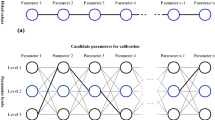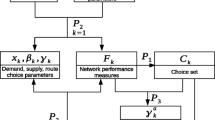Abstract
Traditionally, transport planning model systems are estimated and calibrated in an unstructured way, which does not allow for interactions among included parameters to be considered. Furthermore, the computational burden of model systems plays a key role in choosing a calibration approach, and usually forces modellers to calibrate demand-side and network models separately. Also, trial-and-error methods and expert opinion are currently the backbones of transport model calibration, which leaves room for error in the calibrated parameters. This paper addresses these challenges and suggests a structured approach for determining optimal calibrated transport model parameters. This approach involves joint estimation and calibration of demand and network models, with a major focus on avoiding any manipulation of the OD matrix. The approach can be applied to static or dynamic traffic assignments. The approach is applied by calibrating GTAModel—an example of a large-scale agent-based model system from Toronto, Canada.






Similar content being viewed by others
References
Al-Dujaili, A., Suresh, S.: Multi-objective simultaneous optimistic optimization. Inf. Sci. (Ny) 424, 159–174 (2018). https://doi.org/10.1016/j.ins.2017.09.066
Antoniou, C., Ben-Akiva, M., Koutsopoulos, H.N.: Online calibration of traffic prediction models. Transp. Res. Rec. 1934, 235–245 (2005). https://doi.org/10.1177/0361198105193400125
Arentze, T., Timmermans, H.: A learning-based transportation oriented simulation system. Transp. Res. Part B Methodol. 38, 613–633 (2004). https://doi.org/10.1016/j.trb.2002.10.001
Asakura, Y., Hato, E., Kashiwadani, M.: Origin-destination matrices estimation model using automatic vehicle identification data and its application to the Han-Shin expressway network. Transportation (Amst) 27, 419–438 (2000). https://doi.org/10.1023/A:1005239823771
Auld, J., Mohammadian, A.K.: Activity planning processes in the agent-based dynamic activity planning and travel scheduling (ADAPTS) model. Transp. Res. Part A Policy Pract. 46, 1386–1403 (2012). https://doi.org/10.1016/j.tra.2012.05.017
Balakrishna, R.: Off-line calibration of dynamic traffic assignment models. Ph.D. thesis, Massachusetts Institute of Technology, Cambridge (2006)
Balakrishna, R., Ben-Akiva, M., Koutsopoulos, H.: Offline calibration of dynamic traffic assignment: simultaneous demand-and-supply estimation. Transp. Res. Rec. 2003, 50–58 (2007). https://doi.org/10.3141/2003-07
Bhat, C.R., Guo, J.Y., Srinivasan, S., Sivakumar, A.: Comprehensive econometric microsimulator for daily activity-travel patterns. Transp. Res. Rec. 1894, 57–66 (2004)
Bliemer, M., Raadsen, M., Romph, E. De Smits, E.: Requirements for traffic assignment models for strategic transport planning: a critical assessment. In: Australasian Transport Research Forum, pp. 1–25. Brisbane, Australia (2013)
Bowman, J.L., Bradley, M.A., Gibb, J.: The Sacramento activity-based travel demand model: estimation and validation results. In: Proceedings of the European Transport Conference, pp. 1–22. Strasbourg, France (2006)
Box, G.E.P., Behnken, D.W.: Some new three level designs for the study of variables quantitative. Technometrics 2, 455–475 (1960). https://doi.org/10.1080/00401706.1960.10489912
Box, G.E.P., Draper, N.R.: Response Surfaces, Mixtures, and Ridge Analyses. Wiley, Hoboken (2007)
Box, G.E.P., Wilson, K.B.: On the experimental designs for exploring response surfaces. Ann. Math. Stat. 13, 1–45 (1951)
Cipriani, E., Florian, M., Mahut, M., Nigro, M.: A gradient approximation approach for adjusting temporal origin-destination matrices. Transp. Res. Part C Emerg. Technol. 19, 270–282 (2011). https://doi.org/10.1016/j.trc.2010.05.013
Cools, M., Moons, E., Wets, G.: Calibrating activity-based models with external origin-destination information: overview of possibilities. Transp. Res. Rec. 2175, 98–110 (2010). https://doi.org/10.3141/2175-12
Davidson, W., Donnelly, R., Vovsha, P., Freedman, J., Ruegg, S., Hicks, J., Castiglione, J., Picado, R.: Synthesis of first practices and operational research approaches in activity-based travel demand modeling. Transp. Res. Part A Policy Pract. 41, 464–488 (2007). https://doi.org/10.1016/J.TRA.2006.09.003
Deb, K.: Advances in evolutionary multi-objective optimization. In: Fraser, G., Teixeira de Souza, J. (eds.) Search Based Software Engineering. Lecture Notes in Computer Science, vol. 7515, pp. 1–26. Springer, Berlin, Heidelberg (2012)
Derringer, G., Suich, R.: Simultaneous optimization of several response variables. J. Qual. Technol. 12, 214–219 (1980)
Dhiman, G., Kumar, V.: Multi-objective spotted hyena optimizer: a multi-objective optimization algorithm for engineering problems. Knowl. Based Syst. (2018). https://doi.org/10.1016/j.knosys.2018.03.011. (in press)
Donnelly, R., Erhardt, G.D., Moeckel, R., Davidson, W.A.: Advanced practices in travel forecasting. Transportation Research Board of the National Academies, Washington, DC (2010)
Huynh, N., Mahmassani, H.S., Tavana, H.: Adaptive speed estimation using transfer function models for real-time dynamic traffic assignment operation. Transp. Res. Rec. 1783, 55–65 (2002)
Kattan, L., Abdulhai, B.: Noniterative approach to dynamic traffic origin-destination estimation with parallel evolutionary algorithms. Transp. Res. Rec. 1964, 201–210 (2006). https://doi.org/10.3141/1964-22
Khuri, A.I., Mukhopadhyay, S.: Response surface methodology. Wiley Interdiscip. Rev. Comput. Stat. 2, 128–149 (2010). https://doi.org/10.1002/wics.73
Le Doan, D., Ziliaskopoulos, A., Mahmassani, H.: On-line monitoring system for real-time traffic management applications. Transp. Res. Rec. 1678, 142–149 (1999). https://doi.org/10.3141/1678-18
Marget, W.: Experimental designs for multiple responses with different models. Grad, Theses Diss (2015)
McNally, M.: The four step model. In: Handbook of Transport Modelling. Elsevier (2000)
Miettinen, K.: Nonlinear Multiobjective Optimization. Kluwer Academic Publishers, Dordrecht (1999)
Miller, E., Roorda, M.: Prototype model of household activity-travel scheduling. Transp. Res. Rec. 1831, 114–121 (2003). https://doi.org/10.3141/1831-13
Myers, R.H., Montgomery, D.C., Anderson-Cook, C.M.: Response Surface Methodology: Process and Product Optimization Using Designed Experiments. Wiley, Hoboken (2009)
Najmi, A., Duell, M., Ghasri, M., Rashidi, T.H., Waller, S.T.: How should travel demand and supply models be jointly calibrated? Transp. Res. Rec. (2018a). https://doi.org/10.1177/0361198118772954
Najmi, A., Rashidi, T.H., Miller, E.J.: A novel approach for systematically calibrating transport planning model systems. Transportation (Amst) 1, 36 (2018b). https://doi.org/10.1007/s11116-018-9911-6
Nie, Y., Zhang, H.M.: A variational inequality formulation for inferring dynamic origin-destination travel demands. Transp. Res. Part B Methodol. 42, 635–662 (2008). https://doi.org/10.1016/j.trb.2008.01.001
NYMTC: 2010 base year update and validation of the NYMTC. New York Metropolitan Transportation Council (NYMTC), prepared by Parsons Brinckerhoff (2014)
Omrani, R., Kattan, L.: Demand and supply calibration of dynamic traffic assignment models. Transp. Res. Rec. 2283, 100–112 (2012). https://doi.org/10.3141/2283-11
Parsons Brinckerhoff: the MORPC travel demand model validation and final report (2005)
Pendyala, R., Konduri, K., Chiu, Y.-C., Hickman, M., Noh, H., Waddell, P., Wang, L., You, D., Gardner, B.: Integrated land use-transport model system with dynamic time-dependent activity-travel microsimulation. Transp. Res. Rec. 2303, 19–27 (2012). https://doi.org/10.3141/2303-03
Qin, X., Mahmassani, S.H.: Adaptive calibration of dynamic speed-density relations for online network traffic estimation and prediction applications. Transp. Res. Rec. 1, 82–89 (2004). https://doi.org/10.3141/1876-09
Ranade, S.S., Thiagarajan, P.: Selection of a design for response surface. IOP Conf. Ser. Mater. Sci. Eng. 263, 022043 (2017). https://doi.org/10.1088/1757-899X/263/2/022043
Roorda, M.J., Miller, E.J., Habib, K.M.N.: Validation of TASHA: a 24-h activity scheduling microsimulation model. Transp. Res. Part A Policy Pract. 42, 360–375 (2008). https://doi.org/10.1016/J.TRA.2007.10.004
Shao, L., Ehrgott, M.: Discrete representation of non-dominated sets in multi-objective linear programming. Eur. J. Oper. Res. 255, 687–698 (2016). https://doi.org/10.1016/J.EJOR.2016.05.001
Spiess, H.: A Gradient Approach for the O-D Matrix Adjustment Problem. University of Montreal, Montreal, Publication No. 693 (1990)
Toledo, T., Koutsopoulos, H.N., Davol, A., Ben-Akiva, M.E., Burghout, W., Andréasson, I., Johansson, T., Lundin, C.: Calibration and validation of microscopic traffic simulation tools: stockholm case study. Transp. Res. Rec. 1831, 65–75 (2003). https://doi.org/10.3141/1831-08
Train, K.E.: Discrete Choice Methods with Simulation. Cambridge University Press, Cambridge (2003)
Zhang, X., Tian, Y., Jin, Y.: Approximate non-dominated sorting for evolutionary many-objective optimization. Inf. Sci. (Ny) 369, 14–33 (2016). https://doi.org/10.1016/J.INS.2016.06.007
Zhao, Y., Kockelman, K.M.: The propagation of uncertainty through travel demand models: an exploratory analysis. Ann. Reg. Sci. 36, 145–163 (2002)
Funding
Funding was provided by DECRA Australian Research Council (AU) (Grant No. DE170101346).
Author information
Authors and Affiliations
Contributions
AN: literature search and review, research methodology, model development, analysis, manuscript writing. THR: model development, research methodology, manuscript editing. JV: model implementation, analysis. EJM: research methodology, manuscript editing.
Corresponding author
Additional information
Publisher's Note
Springer Nature remains neutral with regard to jurisdictional claims in published maps and institutional affiliations.
Appendices
Appendix 1
Appendix 2
To fit any functional relationship between a set of dependent and independent variables, we need a set of observed values for the variables. In the context of this paper, the calibration parameters and calibration criteria (as the responses of interest) are independent and dependent variables, respectively. Each of the experiments in CCD analysis provides an observed set of values for the parameters and performance criteria (as in Table 1). Although the values for the parameters are determined by central composite designs, the response values for each of the experiments should be calculated. Different formulations can be used for calculating the response values; we use mean Euclidean distance (MED) indicator to calculate the responses of interest for all the criteria. In other words, MED indicators are functions to quantify the performance criteria. In our case study, there are 18 criteria (see Table 2); therefore, 18 MED indicators should be calculated for each of the experimental runs. We use MED indicator using the 1-norm distance measure, as per Eq. (7).
where \(i\) is the experiment number, \(j\) is the response measure, \(k\) is the observed statistic number, \(n_{j}\) is the total number of records for response measure \(j\), and \(\Delta v\) represents the difference between the observed and simulated values. To illustrate this further, consider an observed screenline dataset with 500 records. In this example, reproducing screenline counts is one of the response measures. Each of the records is an observed statistic, and the total number of records in the dataset is 500.
Since the MED values are often of different units and scales (depending on the scales of \(n\) and \(\Delta v\)), it could significantly affect the output of Eq. (2). Therefore, the performance indicators of the experiments should be scaled before importing them into the optimisation formula. As a result, the performance indicators are replaced with the normalised indicators as in Eq. (8).
where \(\mu_{j}\) and \(\sigma_{j}\) are the mean and standard deviation of the performance indicators (MED) for response \(j\) over all the experiments. The smaller NMED means a lower difference between the simulated and observed statistics and, therefore, better performance.
Rights and permissions
About this article
Cite this article
Najmi, A., Rashidi, T.H., Vaughan, J. et al. Calibration of large-scale transport planning models: a structured approach. Transportation 47, 1867–1905 (2020). https://doi.org/10.1007/s11116-019-10018-6
Published:
Issue Date:
DOI: https://doi.org/10.1007/s11116-019-10018-6




